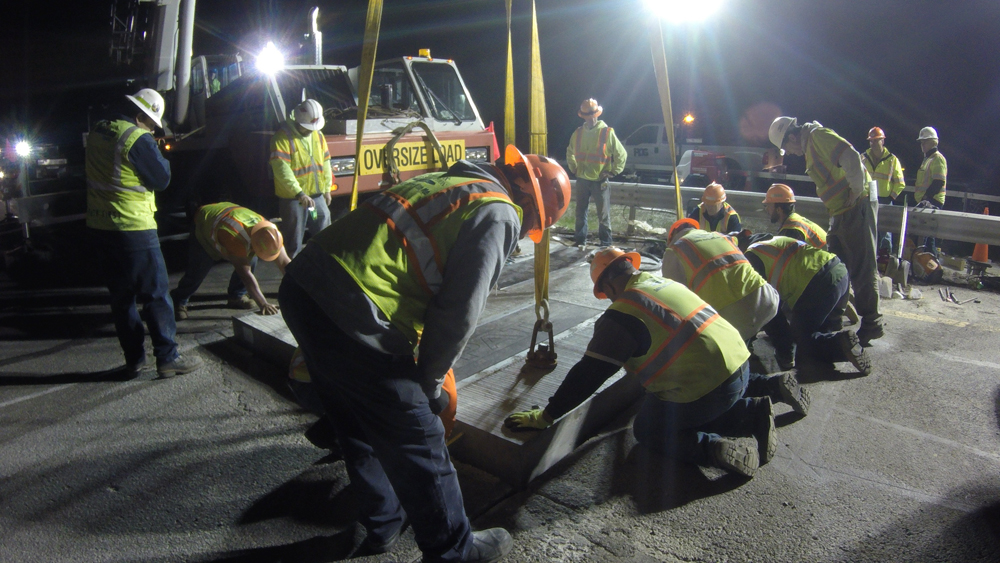Alan Dron looks at where WIM is heading in the near future.
As Weigh-In-Motion (WIM) systems grow in sophistication and accuracy, they are increasingly being used in more active roles to help ensure road safety through enforcement action against overweight vehicles.
Currently the capabilities of the latest-generation WIM systems are outstripping legislation but that situation is about to change in several nations and so enforcement action by WIM systems is likely to become a much more frequent occurrence within the next few years.
In Colorado, one site has both piezo-electric and Intercomp’s strain gauge sensors in the same lane, with Canadian company
Intercomp plans to partner with IRD for a more extensive survey when the weather in the region improves in the spring. This will involve a calibrated truck travelling over both types of sensor to provide very precise evaluation. On the other side of the world, Intercomp has started selling products into China, for the authorities to evaluate.
“They can use them for data collection, but I think they’re going to be screening for enforcement,” says Arnold, adding: I understand that many Chinese roads are tolled and many companies have a tendency to overload vehicles because they want to pay fewer tolls, but of course that causes the roadways to deteriorate.”
According to Arnold it is not unknown for a lorry that should have a maximum operating weight of 36.3tonnes (80,000lbs) to be found on Chinese roads weighing 68tonnes (150,000lbs). If enforcement standards to catch overloaded vehicles could be improved, he believes the authorities could structure tolls in such a way as to incentivise truck users not to overload their vehicles and to use two vehicles rather than one.
Currently, however, much of the company’s effort goes into toll plazas as it is advocating the integration of WIM into plaza solutions.
“The next step we’re focusing on is direct enforcement, similar to issuing a speeding ticket. As you pass the WIM site it will be automatically enforced.” Equipment capable of handling these enforcement duties is undergoing, or has recently received, type approval in several countries and multiple nations are modifying laws to allow WIM to be used for these duties. He anticipates this will happen within the next two years.
“You need a legislative basis for dynamic weighing. The Czech Republic is the first country to have this law. It’s just a question of timing of the tender and the rolling out of WIM stations,” he says.
New laws are required because using WIM to handle enforcement duties will mean the authorities will require a high level of evidence ‘on the record’. In the US, Kapsch has deployed a new, multifaceted WIM system that involves considerably more than just weight measurement. It combines ANPR with a sophisticated enforcement back office where a vehicle can be checked against local and national databases for factors such as valid licences and whether its insurance is up-to-date.
Daxberger has detected a trend towards authorities asking for direct enforcement capabilities in their new systems and the company is testing various arrangements of sensors to see which gives the best result.
Traditionally, static scales have been accurate to around 1% while dynamic scales have only been accurate to +/- 5%. “We have experience in our stations of getting to 2.5% and the aim is to get closer to the static level of 1%,” says Daxberger.
In the US, meanwhile, high-speed WIM is increasingly being used for prescreening and diverting potential violators to a static weigh station, rather than for direct enforcement. There is definitely a trend towards WIM installations as opposed to static sites as the former become more accurate, says Arnold.
However, Terry Bergan, president and CEO of IRD points out that there are many laws entrenched in judicial codes – notably in North America – that demand a level of accuracy that only static scales can currently reach.
Other countries, such as Russia, China, Brazil, Vietnam and some Eastern European nations, on the other hand, are now looking at using high-speed WIM for enforcement. That could involve trucks moving at speeds of 40km/hr (25mph), with multiple sets of roadway sensors employed to give the required degree of accuracy.
Currently, he says accuracy levels are such that multiple sets of sensors are required to give an average reading. This is particularly the case in areas where the smoothness of the roadway – or lack of it – could have an impact on the readings given by the sensors: “You get the dynamics of a truck on a rough road and you can guess how accurate your WIM is going to be.”
That combination of a truck’s dynamics, smoothness of the roadway and the accuracy of the sensor used for WIM make getting a really accurate result a complex equation, “but if you talk to the authorities, their number one concern right now is accuracy”.
Adding to the problem was the fact that different sensors had different levels of reliability and mean times between failure.
Bergan says: “Over the years, that life expectancy had improved substantially: “In the old days you were lucky to get a year out of a sensor. [Today], in many cases, a sensor will outlast a roadway.”
Having solved the durability problem, improved accuracy is now the holy grail authorities are pursuing, added IRD’s executive vice-president and COO Randy Hanson. Much research and development funding is being devoted to that search.
In terms of future trends, Bergan believed that tyre performance is coming under much more scrutiny, following the introduction by tyre manufacturers of high-pressure and/or wide-based tyres.
The jury remains out on whether wide-based tyres do more or less damage to the roadway, says Hanson, and new sensors would need to be created to measure how many wide-based tyres were on trucks. “If you can combine tyre width and tyre pressure measurement with a WIM measurement into one sensor suite, that’s a very significant opportunity in the marketplace.”
That opportunity would be even greater if those factors could be combined with greater accuracy, he says.
“I think we’re one to two years away; some things are being validated at this point.” That would come in the form of both ‘tweaked’ existing sensors and new developments, he believes.
“Authorities have a lot of existing installations and they’re going to want to augment those with technologies that provide additional value,” says Hanson. Completely new installations would follow later.
Behind a new generation of sensors would come improved processing and analytical capabilities because WIM also plays a big role in providing vital background data that will inform future transportation decisions.
“WIM systems are increasingly used as an integral part of complex ITS systems addressing the demand for traffic data in real time,” notes Tomas Pospisek, EMEA sales manager Road & Traffic with measurement technology specialists Kistler Eastern Europe.
“WIM systems are becoming more and more accurate and capable of handling non-standard driving situations, such as stop-and-go traffic (typically at a toll booth) or vehicles changing lanes in multi-lane roads.”
The basic need of WIM users such as road authorities, toll operators and weight enforcement agencies for quality, reliable data has not changed, says Pospisek and those requirements are increasing. Accuracy and identification systems are steadily improving. Direct enforcement by WIM, as well as toll-by-weight systems capable of working at highway speeds have become near-term trends, he says.
- ABOUT THE AUTHOR: Alan Dron is a freelance journalist working in the transport sector and regularly reports from major ITS events.












